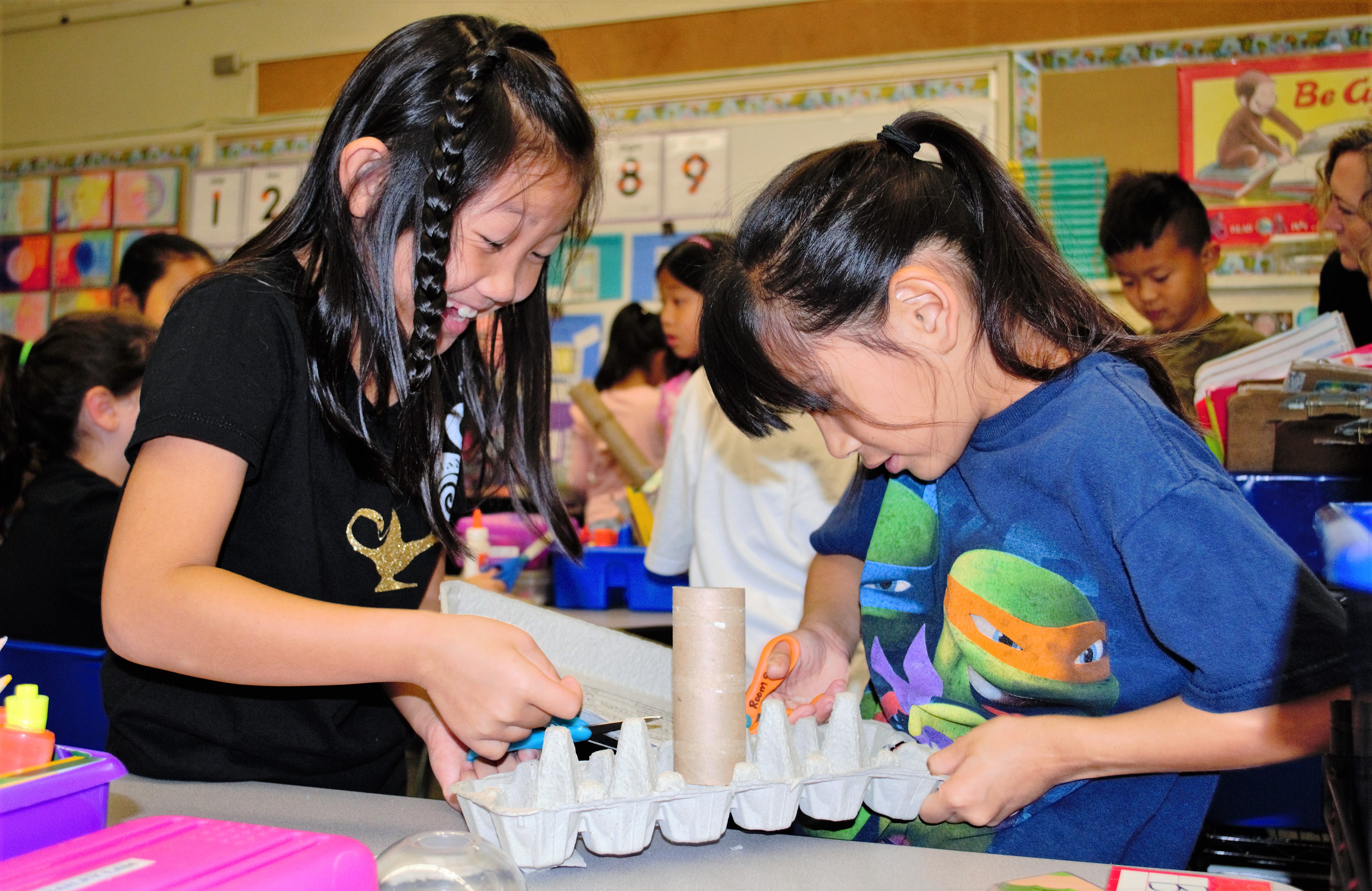San Gabriel Unified School District
San Gabriel Unified Elementary Fosters Student Creativity
SAN GABRIEL, CA – Wilson Elementary second-graders eagerly searched through stores of recycled egg cartons, toilet paper rolls and empty tissue boxes to find the right materials for their latest design challenge.
The social studies-based challenge – designing and constructing a location to sell goods or a service – exemplifies the assignments given by teacher Daphne Chase, who requires her students to create physical objects that reflect themes, concepts and standards from the core curriculum.
Chase, now in her 14th year of teaching at Wilson Elementary, instructs using what is known as Design-based Learning (DBL), which was developed by Cal Poly Pomona professor Doreen Nelson in the 1980s as a way to help students acquire, retain and synthesize classroom lessons through kinesthetic problem-solving.
“The students enjoy building and they feel an attachment to learning when they create things that correlate to the lesson,” Chase said. “This type of instruction makes students think critically and they end up retaining more information because they engage with what they are learning.”
Chase earned her master’s degree in DBL from Cal Poly Pomona in June, and since then she has redeveloped her class curriculum to fit DBL criteria.
At the start of the school year, students were asked to design a creature using cardboard and recycled materials, or what the second-graders call happy trash. These creatures are used as reference points for the students as they learn different concepts that connect to the core curriculum, such as characterization in language arts and primary and secondary sources in social studies.
To develop their creature, students included character traits, wants and needs. They then built a shelter for their creature, while considering the traits as well as materials that would work best.
“My creature is happy living inside her shelter; she has a lot of food to eat and now that she’s selling goods she’s going to make a lot of money,” Wilson second-grader Jia Mistry said. “I really love building and I love how we can build with happy trash instead of normal bricks and stuff.”
One key component of DBL is revision, which helps students understand the process of making a mistake and thinking critically to resolve it.
After a design challenge, students present their creations to the class to explain and defend the choices they made while building. Following the presentation, students discuss the design strengths and help address the areas that need revision.
“After assigning the first design challenge, I saw that students had a passion for what they were creating and they were engaged with the lesson in a way that I hadn’t seen before,” Chase said. “Their work was done at a higher quality and they were excited about what they were doing.”
Chase hopes DBL will expand to other San Gabriel Unified schools. She recently met with McKinley Elementary teachers Lynn Fisher and Jenna Dizon to discuss tips for implementing the methodology and overcoming instructional challenges.
“We are proud to have teachers like Daphne Chase who are continually working to integrate hands-on, interactive projects into our students’ daily education and boost academic excellence,” San Gabriel Unified Superintendent Dr. John Pappalardo said. “Daphne is an impactful leader for her students and a valued member of the SGUSD family.”
PHOTO CAPTIONS:
110217_SANGAB_DBL1: Wilson Elementary second-graders eagerly work on their latest design challenge to construct their interpretation of a location that provides a good or service. The assignment is part of Design-based Learning (DBL) instruction, which was developed as a way to help students acquire, retain and synthesize classroom lessons through kinesthetic problem-solving.
110217_SANGAB_DBL2: Second-graders from Wilson Elementary work on their social studies-based challenge to create their interpretation of a location that provides a good or service. This exemplifies the weekly assignments given by teacher Daphne Chase, which require her students to create physical objects that reflect themes, concepts and standards from the core curriculum.


San Gabriel Unified Elementary Fosters Student Creativity
San Gabriel Unified School District
- Image Title
- 110217_SANGAB_DBL2
- Image Caption
- 110217_SANGAB_DBL2: Second-graders from Wilson Elementary work on their social studies-based challenge to create their interpretation of a location that provides a good or service. This exemplifies the weekly assignments given by teacher Daphne Chase, which require her students to create physical objects that reflect themes, concepts and standards from the core curriculum.
Right-click on the image to save
- Image Title
- 110217_SANGAB_DBL1
- Image Caption
- 110217_SANGAB_DBL1: Wilson Elementary second-graders eagerly work on their latest design challenge to construct their interpretation of a location that provides a good or service. The assignment is part of Design-based Learning (DBL) instruction, which was developed as a way to help students acquire, retain and synthesize classroom lessons through kinesthetic problem-solving.
Right-click on the image to save


